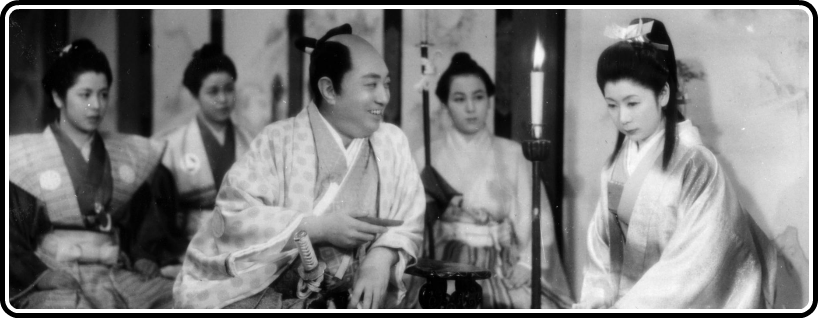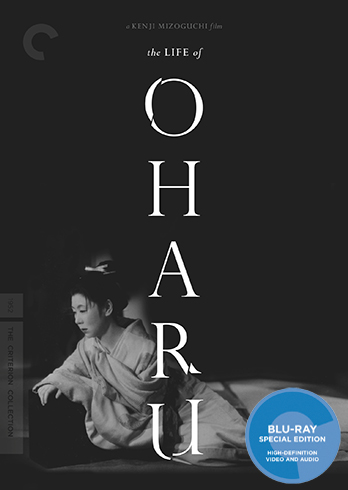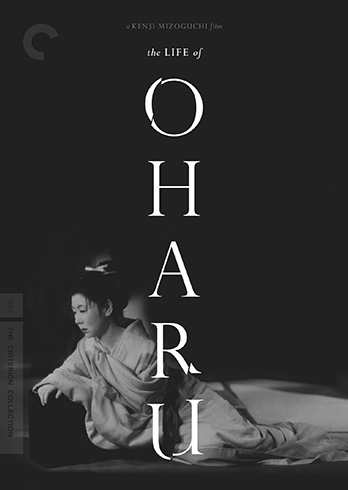
As a film renowned for its underlying admonition to endure profound suffering with serene dignity and composure, I was both pleased and impressed to discover that The Life of Oharu was in fact the product of two fiercely competitive egos coming together to redeem themselves in response to perceived slights and neglect. The first of these towering personalities was, of course, director Kenji Mizoguchi. At the time of the film’s release in 1952, Mizoguchi had been a well-established and highly respected master of Japanese cinema since his breakthrough releases of 1936, Osaka Elegy and Sisters of the Gion. He had managed to forge a path of continued artistic growth through the grim years of the Pacific War and overbearing government involvement in his work, creating the nearly four-hour epic of feudalistic samurai valor The 47 Ronin under the watchful eye of Japan’s imperialist regime in 1941, and had comported himself quite well in the war’s aftermath, perfecting his methods in another classic, historically-based tale, Utamaro and His Five Women. Turning his eye to the plight of contemporary Japanese society, and in particular the hardships suffered by women in the black market chaos under the American occupation, Mizoguchi released Women of the Night, an exploration of the circumstances that pushed desperate women of that time into the sex trade. While these films were all well-received and considered quite successful within the confines of Japanese culture, little or no thought had been given to the possibility of giving them broader exposure through international theatrical runs. But when the relative upstart Akira Kurosawa, a dozen years Mizoguchi’s junior, won the prestigious Silver Lion at the Venice Film Festival for Rashomon, something resembling indignation was kindled in Mizoguchi’s proud spirit. He recognized that the stakes had been raised, that Japanese film was on the brink of earning its well-deserved recognition as “world-class cinema,” and after thirty years in the biz, he was intent on getting a piece of that action.
The other feisty ego whose contributions went into making The Life of Oharu an award-winning and enduring masterpiece was that of its lead female actor, Kinuyo Tanaka. Her career path was by no means exclusively linked to Mizoguchi (she worked with Ozu, Naruse, Gosho and Shimizu, among Japan’s all-time greatest and most prolific directors), but there’s no disputing the fact that he provided her most memorable roles. Their names are forever linked for the work they collaborated on throughout the late 1940s and early 1950s, a partnership that came to an abrupt end when Mizoguchi, for reasons still not entirely clear, openly opposed the offer extended to her to become a director for the Nikkatsu studio. Tanaka did get the job and went on to direct six films altogether. (Three of those titles suggest fascinating echoes of themes from Mizoguchi films she herself performed in: The Wandering Princess, Girls of the Night and Love Under the Crucifix.)
So clearly, Tanaka was a woman of some ambition, a creative talent both on the screen but also behind the camera, not at all the customary role for Japanese women in the cinema industry of that time (and sadly, things don’t appear to have changed all that much in the movie business around the world even to this day.) But what had set her back in the years between her appearance in Women of the Night, one of her earliest star-making roles, and the part that assured her cinematic immortality in The Life of Oharu was an ill-fated trip she took to Hawaii and the United States (when the American flag still only had 48 stars) in 1949. What was undertaken with the intentions of serving as a goodwill tour, a public relations bonanza for both societies that had been in deadly combat with each other just a few years prior, turned quite sour for Tanaka upon her return home, after pictures of her wearing Western attire, dark sunglasses and blowing kisses to her fans were blown up by the conservative cultural forces to provoke outrage and condemnation among the general populace. Apparently Tanaka had gone too far, had stepped unforgivably outside the boundaries that were, to her dismay, still being enforced, at least in the mass consciousness of that time. It was the kind of bad press blowback that could have seriously derailed her career, if she didn’t bounce back strong with a role that shut up the critics and nay-sayers.
I learned all this through one of the relatively few but extremely insightful supplements included on Criterion’s recent release of The Life of Oharu, the film that unofficially serves as Mizoguchi’s counter-punch to Rashomon (both films begin with strangers huddling together under the gate of a city, and unfold as a series of flashbacks) and his first of five consecutive nominees or winners to the Venice Film Festival. Compared to the generously stacked Ugetsu 1953, DVD only) and the lovingly packaged slipcase presentation of 1954’s Sansho the Bailiff (upgraded to blu-ray earlier this year), Oharu is given a fairly mundane treatment. While I don’t think any kind of “downgrade” is especially deserved, I can kind of understand why Criterion lavished more deluxe packaging on the two later films. They each provide more variety in their narrative progression, including moments of spine-tingling mysticism and ethereal beauty that are approached but never quite equaled throughout Oharu’s descent into ever-deepening stages of godforsaken misery. In other words, Sansho and Ugetsu are more surefire crowd-pleasers – but that doesn’t make The Life of Oharu any less essential. In fact, I think the argument can be made that watching and understanding this film provide a key to appreciating Mizoguchi’s subsequent achievements all the more.
The Life of Oharu is the story of a woman born into privilege, the daughter of a samurai born in the late 1600s, who falls into a unstoppable spiral of ruin due to the unforgivable sin of having carnal relations with a servant unworthy of her affections. Never mind the fact that she was merely a sheltered and easily swayed teenager when the offense occurred, or that her ardent suitor was none other than an young Toshiro Mifune (who could resist?!) Despite her sincere intentions and effort to uphold the family honor, she yields to his strenuous advances, and when they’re caught, the condemnation falls not only on her but on her entire household for having failed in their duty to the shogun to raise their daughter the right way.
The collective lapse in decorum constitutes a breach in the social order that can only be repaired by the severest of punishments – not immediate execution but a permanent exile that leads to lasting shame and disgrace, an example that warns all on-lookers to be mindful of their status and to always stay within the restrictive order imposed from above. Oharu’s fall from grace initiates a precipitous decline in her fortunes as the remaining years of her life see her digress from her birth into a noble family into the pain and humiliation associated with just about every role that a woman of her era could occupy, other than the “lady of the manor” that she was supposedly destined to become: peasant farm worker, concubine, mother of a child, elegant but scorned courtesan, artisan’s wife, penniless widow, street-walking prostitute, mendicant beggar, ascetic nun. At every reversal of fortune, as each deprivation mounts, both the men and women in authority around her are inclined to heap the blame upon her for the latest calamity, rarely if ever pausing to consider how they themselves contributed to the adversity and deaf to the protests of those who rise in Oharu’s defense. Of course, Oharu herself is rarely bold enough to speak up on her behalf, and when she does, she never presses the point to become excessively strenuous, recognizing the futility of open resistance. Thoughts of self-immolation as the last best escape from her ordeal are never far from her mind, yet she perseveres, allowing her quiet indignation, the fierce intelligence of her gaze and the quiet dignity of her unconquerable spirit serve as a subtle rebuke to any of her exploiters who are perceptive enough to recognize their failure to hit her where it hurts the most.
Which is not at all to imply that Oharu emerges unscathed from all the abuse. She’s clearly a wounded soul, suffering cynical betrayals and random senseless loss in equal measures. After giving birth to an esteemed lord’s heir, she begins to feel some repose in her role as a favored concubine, only to be coldly turned out from the household having fulfilled her purpose and under accusation of “wearing out” her master by sharing his bed too freely. Turning to the geisha profession as a seeming last resort, her stubborn refusal to disgrace herself when a wealthy patron makes it rain with coinage strewn across the floor of the brothel surprisingly wins his favor, leading him to buy her freedom. But when he turns out to be a fraud, she’s again cut loose from the support she thought she’d found. Even marriage to a humble craftsman ends in disappointment when he’s murdered by thieves. Yes, there’s a certain tragical artifice to Oharu’s forlorn pilgrimage through this vale of tears, and yet her sojourn feels inhabited, realistic and believable because we all know that countless anonymous women have indeed trod that path, both in Japan and in cultures around the world, even to this day.
No sensitive viewer can fail to respond emotionally to the power of Kinuyo Tanaka’s portrayal of Oharu. She convincingly presents the character to us as a teenager, a mature woman and as a withered old crone. When she’s called upon to demonstrate the classical manners of traditional Japanese womanhood, through dance, through ritual gestures and genuflections, through full-bodies swoons that require a “collapsing” movement seemingly prerequisite for any prominent female role in a Mizoguchi film, or even allowing a smile every once in awhile, Tanaka shows herself to be an exquisite talent – always composed, disciplined, self-aware and supremely emotive without ever crossing the line into blatant histrionics or manipulative tear-jerking.
Mizoguchi also earns the praises heaped upon him over the years, with superb visual compositions and the fabled long takes made possible by his stunningly fluid camera movements. Set pieces in The Life of Oharu are so frequent and lacking in ostentation that it’s often easy to forget just how much choreography and rehearsal had to go into the construction of such scenes. An early outburst by Oharu, when she runs through a forest, pursued by her mother, intent on killing herself after hearing of her lover’s execution, is just one of many standout scenes where a repeat viewing left me wondering just how precisely everything had to be planned for Mizoguchi to get his lens from pointed inside the shack where Oharu receives her letter to a very specific point where she collapses after a mad dash hundreds of feet from where she started, perfectly framed by stalks of tall bamboo on either side.
Then there are the interiors, the shadows and lights, the screened windows, tracking shots that weave and pivot and spin in every conceivable direction, all for such lengths of time as to let the actors show their respective mastery and creating a palpable sense of presence and involvement on the viewer’s part, as if we are genuinely peering in on a world that is at once beautiful, strange, exotic and meticulously well-ordered.
Setting technical brilliance aside for a moment, as a storyteller, Mizoguchi is most prominently regarded for his signature advocacy for women’s social justice. That’s the theme that unifies his Eclipse Series “Fallen Women” collection, ranging from those first works of his artistic maturity right up until his final film, Street of Shame, released shortly before he died much too young in 1956. The oppression of women comes through clearly in Ugetsu and Sansho the Bailiff as well, but The Life of Oharu stands as his most sustained exploration of that idea, demonstrating that the exploitation and hypocrisy that women have to routinely put up with is not a mere moral defect manifested by a few corrupt characters, but is generated from within the very heart of the prevailing social order – a status quo that indisputably favors men and actually encourages them to make scapegoats of the women around them so that they can secure further advantages. Furthermore, Oharu suffers at the behest of women who have also bought into that system, accepting the notion that her unworthiness and immodesty brought misfortune upon her -never realizing that they oppress themselves even in the process of heaping scorn upon their disreputable sister.
The Life of Oharu also presents what is probably Mizoguchi’s most in-depth application of Buddhist spirituality to the predicament of his characters. The framing scenes of Oharu as an old women in the temple, where statues of the Buddha induce brief hallucinations that trigger sad old memories and a physical collapse, hint at a form of salvation through meek, long-suffering piety. After Oharu recovers, she’s informed that the son she’d been separated from for so long was about to take his place as heir to the manor after the death of his father. This leads to the final bout of suspense, as mother seeks a reunion with child, only to find that the formalities and rigid protocols forbid anything beyond a most graciously dispensed glimpse of the youthful majesty. It’s a incredibly beautiful scene, a passionate depiction of maternal dedication to an unbreakable bond, culminating in Oharu’s mysterious evasion of the men who seek to contain her once and for all. Disappearing without explanation, we see the guards running around the palace grounds in confusion over the roof of a palanquin like those that had been used in the past to transport Oharu in both splendid comfort, and as a helpless captive.
We then find Oharu, after seemingly evaporating as a mist, embodied once again on the streets of a city, begging for coins at the doors of strangers, croaking out a low, guttural hymn, bowing in prayer to a pagoda in the distance. Her path, finally, has settled on a course of renunciation and acceptance, since her ebbing energy and diminished social standing leave her no other options. But her feeble solo chant, a vow of eventual attainment, somehow grows into a robust choir. Withered and whittled down to her essence, The Life of Oharu draws to its close, imbued with a hard-earned power to change the world through the testimony of indomitable grace.






![Bergman Island (The Criterion Collection) [Blu-ray]](https://criterioncast.com/wp-content/uploads/2022/11/bergman-island-the-criterion-collection-blu-ray-400x496.jpg)
![This Is Not a Burial, It’s a Resurrection (The Criterion Collection) [Blu-ray]](https://criterioncast.com/wp-content/uploads/2022/11/this-is-not-a-burial-its-a-resurrection-the-criterion-collection-blu-ray-400x496.jpg)
![Lars von Trier's Europe Trilogy (The Criterion Collection) [The Element of Crime/Epidemic/Europa] [Blu-ray]](https://criterioncast.com/wp-content/uploads/2022/11/lars-von-triers-europe-trilogy-the-criterion-collection-the-element-of-400x496.jpg)
![Imitation of Life (The Criterion Collection) [Blu-ray]](https://criterioncast.com/wp-content/uploads/2022/11/imitation-of-life-the-criterion-collection-blu-ray-400x496.jpg)
![The Adventures of Baron Munchausen (The Criterion Collection) [4K UHD]](https://criterioncast.com/wp-content/uploads/2022/11/the-adventures-of-baron-munchausen-the-criterion-collection-4k-uhd-400x496.jpg)
![Cooley High [Criterion Collection] [Blu-ray] [1975]](https://criterioncast.com/wp-content/uploads/2022/11/cooley-high-criterion-collection-blu-ray-1975-400x496.jpg)